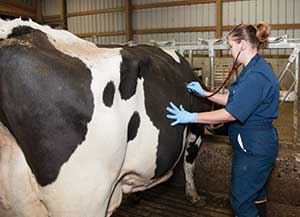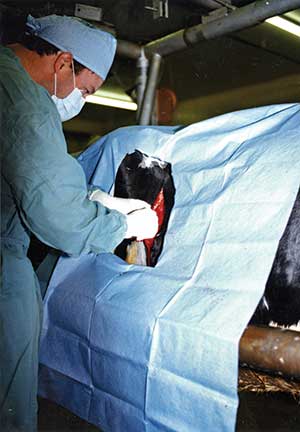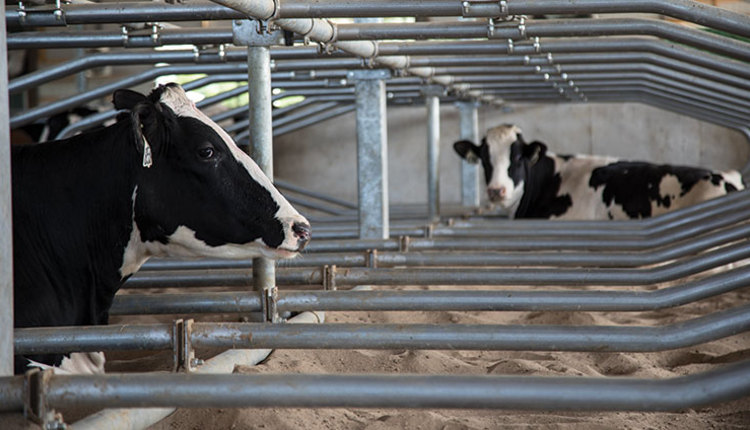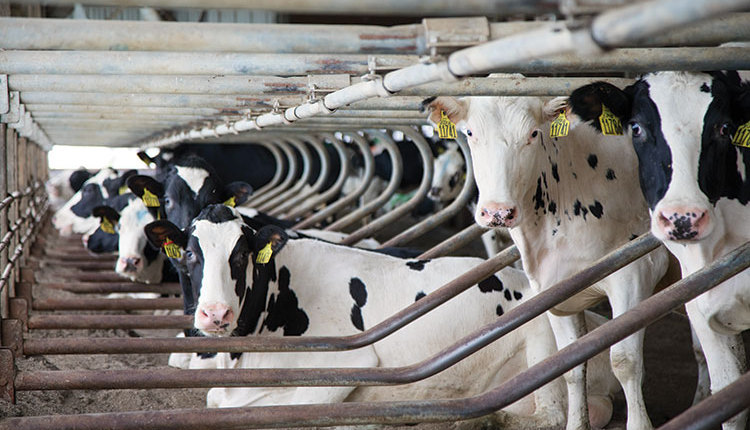The author is a large-herd veterinarian based in Jerome, Idaho.
 Mother Nature made two great mistakes when she designed the dairy cow. First, she placed the cow's udder on the underside, between the back legs, where the teats are exposed to moisture, manure and trauma. Second, while she fixed the first three compartments of the ruminant stomach firmly in place, she made the abomasum, the fourth and final compartment of the stomach, mobile and free to float in the abdominal cavity. Whether termed a "twisted stomach" or DA, abomasal displacements are largely a consequence of the anatomy of the ruminant forestomachs.
Mother Nature made two great mistakes when she designed the dairy cow. First, she placed the cow's udder on the underside, between the back legs, where the teats are exposed to moisture, manure and trauma. Second, while she fixed the first three compartments of the ruminant stomach firmly in place, she made the abomasum, the fourth and final compartment of the stomach, mobile and free to float in the abdominal cavity. Whether termed a "twisted stomach" or DA, abomasal displacements are largely a consequence of the anatomy of the ruminant forestomachs.
Displacements can be either right or left. Left displaced abomasums (LDAs) are most common in the first two weeks of lactation. Right displacements are sporadic, less common, and can occur throughout lactation or even during the dry period.
Herds are doing a good job when LDAs are under 2 to 3 percent. Unfortunately, some farms can have LDAs ranging up to 20 percent or more. Fortunately for the cow and dairymen, LDAs are readily corrected through surgery, toggle fixation or, in some cases, medical intervention.
In these days of higher cull cow prices, I've noticed a trend toward sending cows afflicted with DAs for salvage or slaughter. I believe the routine or indiscriminate salvage of DA cows is a mistake. It is a simple calculation to determine the economics of DA surgery. Most veterinarians charge between $150 to $180 for a surgical DA correction. The same can even be said for the trickier RDA (right displaced abomasum) or RAV (right abomasal volvulus).
Let's review the math
 As an example of the economics of culling versus operating or cutting, if one were to forego surgery and salvage ("beef") the cow instead, you incur the cost to replace her (assuming you want to maintain herd size). If a springing heifer is purchased for $1,500, and beef income is $810 (60 cents times 1,350 pounds), the cost to the producer is $690. One theoretically saves $540 by doing surgery.
As an example of the economics of culling versus operating or cutting, if one were to forego surgery and salvage ("beef") the cow instead, you incur the cost to replace her (assuming you want to maintain herd size). If a springing heifer is purchased for $1,500, and beef income is $810 (60 cents times 1,350 pounds), the cost to the producer is $690. One theoretically saves $540 by doing surgery.
Photo: As long as she is diagnosed early and given appropriate medical aftercare, DA correction allows you to "get your cow back." She should return to production and finish a successful lactation.
There are many other factors that one can introduce that influence the decision one way or the other. One such factor favoring surgery includes the animal's age. While one can argue that a first-calf heifer with an LDA may have a brighter future ahead of her, she is unproven. A second- or greater-lactation cow will have at least one lactation's worth of production data to include in decision making and theoretically should milk more than a first-lactation replacement. Also, avoiding the purchase of a replacement from outside the herd has obvious biosecurity advantages.
What are your current options to correct LDAs? Surgery ("cutting") is historically the most common and, as I will explain, is likely the best. (Since RAVs are surgical emergencies and usually uncommon, I'll concentrate on LDA correction options.) There are several surgical approaches. They include right paramedian abomasopexy, right flank omentopexy, right flank pyloro-omentopexy and left flank abomasopexy. Each technique has advantages and disadvantages.
Right paramedian abomasopexy requires that the cow be in dorsal recumbency (on her back). During surgery she may struggle, bloat or regurgitate rumen contents and acquire aspiration pneumonia. Omentopexies may stretch or break, resulting in a recurrence of the displacement in that or a future lactation. Left flank abomasopexy usually requires an assistant. All the standing techniques require that the cow be stable and able to remain upright and on her legs during the procedure. I like to say that the ideal surgical technique is the one your veterinarian is comfortable with and has success carrying out.
Surgical repairs create long-lasting, usually permanent adhesions between the abomasum and/or omentum and body wall. It should be curative and last the lifetime of the cow. Very importantly, surgical correction allows an exploration of the rest of the abdominal cavity. Potentially complicating conditions such as fatty liver, liver abscesses, lymphosarcoma (cancer), peritonitis and hardware disease, for example, can all be detected during surgery. This allows your veterinarian to provide an accurate prognosis.
Nonsurgical options
Toggling or "blind tack down" is another popular technique for LDA correction. In the hands of a competent, skilled operator, toggling can result in a successful return to lactation of LDA cows. In my experience, the adhesions formed by these methods may not be as durable as those achieved by open surgical correction. An exploratory examination of the abdomen is obviously not possible. There is the risk that an organ other than the abomasum is penetrated by the toggle or needle, producing peritonitis and perhaps death.
As with the right ventral paramedian technique, the cow must be cast onto her back. Aspiration pneumonia is a possibility, as is injury to the assistants should the cow struggle and kick. Use extreme caution when restraining a cow on her back for blind tack downs or toggling.
Medical correction of LDAs also can be attempted in the case of animals that are not ideal surgical candidates. Cows with LDAs often are hypocalcemic. Calcium plays an important role in smooth muscle function. Providing supplemental calcium orally and intravenously is an important adjunct treatment for LDA cows.
Ketosis reduces a cow's appetite. Reduced food intake slows down gastrointestinal tract transit, potentially allowing gases to be produced in the abomasum and producing displacements. Treating ketosis will enhance her appetite and help fill her rumen, thus physically impeding abomasal displacement. This is the theory behind pumping fresh and off-feed cows with large amounts (10 to 15 gallons) of water.
Rolling the cow first, then aggressively treating concurrent diseases can provide some success with medical DA treatment. Obviously, a medically corrected LDA is still prone to future displacements.
Prompt, thorough and effective postsurgical treatment of concurrent diseases is essential to a DA cow's recovery and return to production and profitability. Metritis, ketosis and mastitis all need to be addressed if we are to expect a return on our surgical investment. Early diagnosis of DAs also aids in recovery. Careful observation, daily milk weight recording and BHBA (beta-hydroxybutyrate) monitoring of fresh cows can all help detect animals with displaced abomasa.
Click here to return to the Animal Care E-Sources
140510_335
 Mother Nature made two great mistakes when she designed the dairy cow. First, she placed the cow's udder on the underside, between the back legs, where the teats are exposed to moisture, manure and trauma. Second, while she fixed the first three compartments of the ruminant stomach firmly in place, she made the abomasum, the fourth and final compartment of the stomach, mobile and free to float in the abdominal cavity. Whether termed a "twisted stomach" or DA, abomasal displacements are largely a consequence of the anatomy of the ruminant forestomachs.
Mother Nature made two great mistakes when she designed the dairy cow. First, she placed the cow's udder on the underside, between the back legs, where the teats are exposed to moisture, manure and trauma. Second, while she fixed the first three compartments of the ruminant stomach firmly in place, she made the abomasum, the fourth and final compartment of the stomach, mobile and free to float in the abdominal cavity. Whether termed a "twisted stomach" or DA, abomasal displacements are largely a consequence of the anatomy of the ruminant forestomachs.Displacements can be either right or left. Left displaced abomasums (LDAs) are most common in the first two weeks of lactation. Right displacements are sporadic, less common, and can occur throughout lactation or even during the dry period.
Herds are doing a good job when LDAs are under 2 to 3 percent. Unfortunately, some farms can have LDAs ranging up to 20 percent or more. Fortunately for the cow and dairymen, LDAs are readily corrected through surgery, toggle fixation or, in some cases, medical intervention.
In these days of higher cull cow prices, I've noticed a trend toward sending cows afflicted with DAs for salvage or slaughter. I believe the routine or indiscriminate salvage of DA cows is a mistake. It is a simple calculation to determine the economics of DA surgery. Most veterinarians charge between $150 to $180 for a surgical DA correction. The same can even be said for the trickier RDA (right displaced abomasum) or RAV (right abomasal volvulus).
Let's review the math
 As an example of the economics of culling versus operating or cutting, if one were to forego surgery and salvage ("beef") the cow instead, you incur the cost to replace her (assuming you want to maintain herd size). If a springing heifer is purchased for $1,500, and beef income is $810 (60 cents times 1,350 pounds), the cost to the producer is $690. One theoretically saves $540 by doing surgery.
As an example of the economics of culling versus operating or cutting, if one were to forego surgery and salvage ("beef") the cow instead, you incur the cost to replace her (assuming you want to maintain herd size). If a springing heifer is purchased for $1,500, and beef income is $810 (60 cents times 1,350 pounds), the cost to the producer is $690. One theoretically saves $540 by doing surgery. Photo: As long as she is diagnosed early and given appropriate medical aftercare, DA correction allows you to "get your cow back." She should return to production and finish a successful lactation.
There are many other factors that one can introduce that influence the decision one way or the other. One such factor favoring surgery includes the animal's age. While one can argue that a first-calf heifer with an LDA may have a brighter future ahead of her, she is unproven. A second- or greater-lactation cow will have at least one lactation's worth of production data to include in decision making and theoretically should milk more than a first-lactation replacement. Also, avoiding the purchase of a replacement from outside the herd has obvious biosecurity advantages.
What are your current options to correct LDAs? Surgery ("cutting") is historically the most common and, as I will explain, is likely the best. (Since RAVs are surgical emergencies and usually uncommon, I'll concentrate on LDA correction options.) There are several surgical approaches. They include right paramedian abomasopexy, right flank omentopexy, right flank pyloro-omentopexy and left flank abomasopexy. Each technique has advantages and disadvantages.
Right paramedian abomasopexy requires that the cow be in dorsal recumbency (on her back). During surgery she may struggle, bloat or regurgitate rumen contents and acquire aspiration pneumonia. Omentopexies may stretch or break, resulting in a recurrence of the displacement in that or a future lactation. Left flank abomasopexy usually requires an assistant. All the standing techniques require that the cow be stable and able to remain upright and on her legs during the procedure. I like to say that the ideal surgical technique is the one your veterinarian is comfortable with and has success carrying out.
Surgical repairs create long-lasting, usually permanent adhesions between the abomasum and/or omentum and body wall. It should be curative and last the lifetime of the cow. Very importantly, surgical correction allows an exploration of the rest of the abdominal cavity. Potentially complicating conditions such as fatty liver, liver abscesses, lymphosarcoma (cancer), peritonitis and hardware disease, for example, can all be detected during surgery. This allows your veterinarian to provide an accurate prognosis.
Nonsurgical options
Toggling or "blind tack down" is another popular technique for LDA correction. In the hands of a competent, skilled operator, toggling can result in a successful return to lactation of LDA cows. In my experience, the adhesions formed by these methods may not be as durable as those achieved by open surgical correction. An exploratory examination of the abdomen is obviously not possible. There is the risk that an organ other than the abomasum is penetrated by the toggle or needle, producing peritonitis and perhaps death.
As with the right ventral paramedian technique, the cow must be cast onto her back. Aspiration pneumonia is a possibility, as is injury to the assistants should the cow struggle and kick. Use extreme caution when restraining a cow on her back for blind tack downs or toggling.
Medical correction of LDAs also can be attempted in the case of animals that are not ideal surgical candidates. Cows with LDAs often are hypocalcemic. Calcium plays an important role in smooth muscle function. Providing supplemental calcium orally and intravenously is an important adjunct treatment for LDA cows.
Ketosis reduces a cow's appetite. Reduced food intake slows down gastrointestinal tract transit, potentially allowing gases to be produced in the abomasum and producing displacements. Treating ketosis will enhance her appetite and help fill her rumen, thus physically impeding abomasal displacement. This is the theory behind pumping fresh and off-feed cows with large amounts (10 to 15 gallons) of water.
Rolling the cow first, then aggressively treating concurrent diseases can provide some success with medical DA treatment. Obviously, a medically corrected LDA is still prone to future displacements.
Prompt, thorough and effective postsurgical treatment of concurrent diseases is essential to a DA cow's recovery and return to production and profitability. Metritis, ketosis and mastitis all need to be addressed if we are to expect a return on our surgical investment. Early diagnosis of DAs also aids in recovery. Careful observation, daily milk weight recording and BHBA (beta-hydroxybutyrate) monitoring of fresh cows can all help detect animals with displaced abomasa.
140510_335











